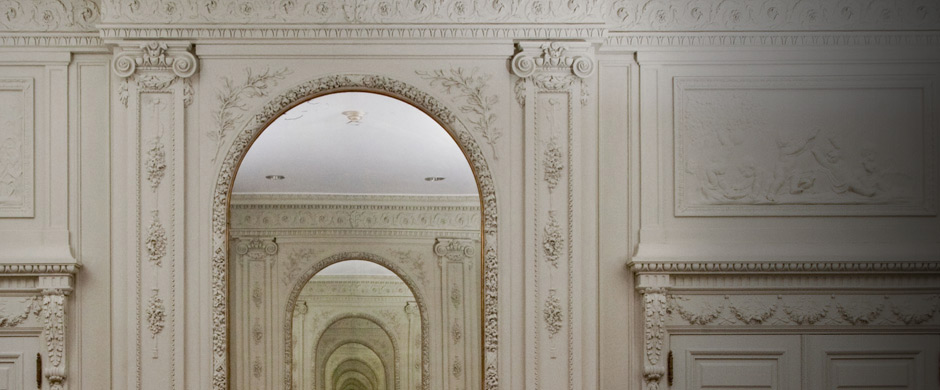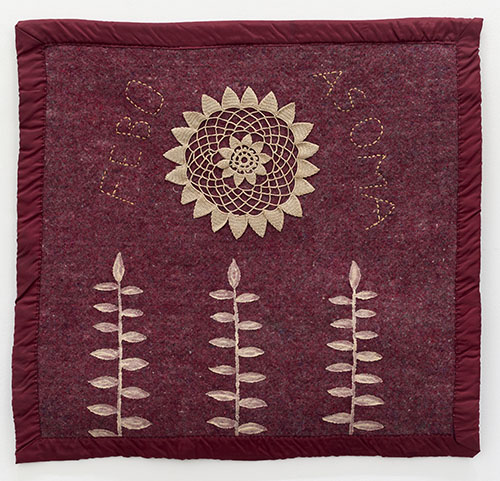 | ON DISPLAY
| ON DISPLAY

The Spring 2023 Duke House Exhibition
Feliciano Centurión:
Telas y Textos
Since 1932 the Institute of Fine Arts has been dedicated to graduate teaching and advanced research in the history of art, archaeology, and conservation. The Duke House Exhibition Series brings contemporary art to the walls of the Institute's landmarked James B. Duke House. The work is displayed in the beaux-arts interior of the former residence of the Duke Family, juxtaposing the historic with the contemporary and inviting viewers to engage with both the past and future of the Institute. Since 2019, the Institute for Studies on Latin American Art (ISLAA) is proud to support the Duke House Exhibition Series to showcase the work of Latin American artists.

Feliciano Centurión:
Telas y Textos
February 6 – May 19, 2023
The Institute of Fine Arts, New York University
1 East 78th Street
New York, NY 10075
The Institute of Fine Arts, New York University is pleased to present Paraguayan artist Feliciano Centurión’s third solo exhibition in the United States. Curated by Diana Cao, Tatiana Marcel, and Nicasia Solano, Feliciano Centurión: Telas y Textos provides an opportunity to examine the aesthetic and material interplay of text, fabric, and found objects in his oeuvre. The exhibition will be on view at the Institute of Fine Arts’ James B. Duke House from February 6 – May 19, 2023.

Feliciano Centurión, Febo Asoma, 1990-1993, Mixed media. Image courtesy: Estate of Feliciano Centurión and Institute for Studies on Latin American Art (ISLAA), New York.
Feliciano Centurión: Telas y Textos showcases the artist’s embroideries on various readymade textiles executed between 1990 and 1994, highlighting the latter years of Centurión’s short, but prolific career. The four major works in the exhibition feature embroidered texts, juxtaposing floral images with both political and personal phrases. The accompanying archival display presents smaller textile works including the artist’s signature whimsical animal motifs and two sculptures from his Familia series.
Centurión’s textiles reflect his upbringing in a matriarchal Paraguayan household, and his experiences as a queer artist in Buenos Aires, Argentina, where he lived for most of his life. He often incorporated historically feminized crafts such as knitting, crocheting, and embroidering. Throughout his practice, Centurión incorporated ordinary household items such as frazadas (blankets), handkerchiefs, and pillowcases bought from local street markets. The prevalence of textiles in Centurión’s work is in keeping with Guaraní weaving traditions and reflects the influence of the Indigenous cultures native to Argentina, Bolivia, Brazil and most ubiquitously, Paraguay, where Guaraní is one of the country’s two official languages. The craftworks in this exhibition apply the technique of ñandutí (meaning “spider web” in Guaraní), an intricate method of lace weaving traditionally passed down from mother to daughter. As seen in the four larger works in the exhibition, a key identifying characteristic of these weblike fabrics is the round center, called the “apyte,” from which geometric forms then radiate. Centurión’s early works were bright, brash, abstract figurative compositions that evolved into the embroidered blankets seen in the exhibition.
Having witnessed military dictatorships in both Paraguay and Argentina during his lifetime, Centurión flourished in Argentina after the collapse of the country’s authoritarian regime in 1983. He found a lively community at the Centro Cultural Rector Ricardo Rojas in Buenos Aires and participated in thirty-one solo exhibitions in Argentina and Paraguay between 1990 and his death in 1996. After being diagnosed with HIV in 1992, Centurión began chronicling his declining health by weaving texts onto increasingly smaller and more intricate fabrics. The sentimental words expressing notions of love, desire, and longing for home, coupled with the soft textiles convey a humanizing sense of warmth, intimacy, and comfort, which contrasted with the public stigmatization of the virus and its victims brought on by reckless government policies and media reports. He also used bright colors and animals from his childhood, such as snails and crocodiles, to present kitsch imagery as both humorous anecdotes and bold declarations of life. Centurión’s frazada works celebrate his matrilineal upbringing and Paraguayan heritage, using embroidery to subvert gender norms, express his queer identity, and elevate the status of textile art to that typically reserved for high art.
Feliciano Centurión (1962-1996) was a Paraguayan textile artist and painter. Born in San Ignacio, Paraguay, his family fled to Formosa, Argentina to escape Alfredo Stroessner’s military dictatorship in Paraguay. In Formosa, he studied plastic arts at the Oscar R. Albertozzi School of Fine Arts. He then permanently relocated to Buenos Aires, Argentina, where he studied painting at the Prilidiano Pueyrredón School of Fine Arts, and the Ernesto de la Cárcova Superior School of Fine Arts. Centurión’s first solo exhibition was held in 1982 at the Estimulo de Bellas Artes in Asunción, Paraguay. Throughout the late 1980s and the 1990s, he was a prominent figure at the Centro Cultural Rector Ricardo Rojas in Buenos Aires. During this time, he exhibited works in Buenos Aires and Asunción, and represented Paraguay in the fifth Havana Biennial in 1994. Centurión passed away at 34 years old due to AIDS-related complications.
Most recently, Centurión’s works have been the subject of a solo presentation in Affective Affinities, the 33rd São Paulo Biennial, São Paulo (2018); Abrigo, Americas Society, New York (2020); and Ñande Róga, Hessel Museum of Art, Annandale-on-Hudson, New York (2021). Group exhibitions include Bodies of Water at the 13th Shanghai Biennale, Shanghai (2021); and Eros Rising: Visions of the Erotic in Latin American Art at the Institute for Studies on Latin American Art (ISLAA), New York (2022).
The Institute for Studies on Latin American Art (ISLAA) provided funding and extensive archival and research support. The works on view are on generous loan from the ISLAA collection.
The Institute for Studies on Latin American Art (ISLAA) advances scholarship and public engagement with art from Latin America through its program of exhibitions, publications, lectures, and partnerships with universities and art institutions. Ariel Aisiks founded ISLAA in 2011 to raise the international visibility of art from Latin America. The pursuit of this goal has led to ISLAA’s involvement in more than 400 lectures and conferences, 30 books, and 20 large-scale exhibitions.
Special thanks to Professor Edward J. Sullivan for providing faculty support for this exhibition.
Public programming
Wednesday, April 26, 2023
This event brought together Dr. Mariano López-Seone (New York University), Diana Flatto (University of Pittsburgh), and independent curator Megan N. Liberty for three presentations and a lively panel discussion facilitated by Diana Cao, Tatiana Marcel, and Nicasia Solano, the curators of Feliciano Centurión: Telas y Textos.
learn more Watch online [opens in new window]Expanding on the themes of materiality in Feliciano Centurión: Telas y Textos, Craft and Curation will discuss curatorial practices that have included Centurión, craft practices in Latin America in the 1990s, and craft based curatorial practices in an international contemporary context. Bringing together scholars and curators from a variety of backgrounds, this program will emphasize the versatility of craft, and Centurión’s unique body of work.
Megan N. Liberty is the Art Books section editor at the Brooklyn Rail and co-founder of Book Art Review. In 2023, she curated the traveling exhibition Craft & Conceptual Art: Reshaping the Legacy of Artists' Books. Her writing appears in Hyperallergic, ArtReview, Artforum.com, art-agenda, Art in America, Frieze, NY Review of Books, LA Review of Books, White Review, Art in Print, and elsewhere. She was a 2019-20 AICA/USA and Creative Capital/The Andy Warhol Foundation’s Arts Writing Workshop participant. She has an MA in Art History, with distinction, from the Courtauld Institute of Art, London and a BA in English from Dickinson College, PA.
Mariano López Seoane is a writer, researcher and curator based in Buenos Aires and New York. He is currently the director of the Graduate Program on Gender and Sexuality at UNTREF in Argentina. He also teaches Latin American literature, cultural studies and queer studies at the Department of Comparative Literature at NYU. López Seoane has curated exhibitions and coordinated public programs for ISLAA, MALBA, Museo Nacional de Bellas Artes, the Buenos Aires International Book Fair and Art Basel Cities. He has written extensively on contemporary Latin American literature and arts, focusing on the cultures of sexual and gender dissidents in the Americas, Latin American instances of queer studies and queer activism, and figurations of drug culture and drug related violence in Latin American narrative, film and visual arts. His publications include the volume of essays Donde está el peligro. Estéticas de la disidencia sexual (2022) and the novel El regalo de Virgo (2017).
Diana Flatto is a PhD candidate in the History of Art & Architecture at the University of Pittsburgh currently based in Buenos Aires with the support of a Fulbright Research Fellowship. Her dissertation examines the role of women in shaping antifascist visual culture between Argentina and Uruguay during the 1930s and 1940s. She was previously Assistant Curator at Americas Society, New York, where she co-curated exhibitions of modern and contemporary art of the Americas including Joaquín Orellana: The Spine of Music and assisted on exhibitions including Feliciano Centurión: Abrigo.



